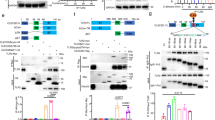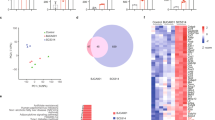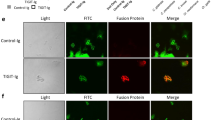Abstract
Immunity to pathogens critically requires pattern-recognition receptors (PRRs) to trigger intracellular signaling cascades that initiate and direct innate and adaptive immune responses. For fungal infections, these responses are primarily mediated by members of the C-type lectin receptor family. In this Review, we highlight recent advances in the understanding of the roles and mechanisms of these multifunctional receptors, explore how these PRRs orchestrate antifungal immunity and briefly discuss progress in the use of these receptors as targets for antifungal and other vaccines.
This is a preview of subscription content, access via your institution
Access options
Subscribe to this journal
Receive 12 print issues and online access
$209.00 per year
only $17.42 per issue
Buy this article
- Purchase on Springer Link
- Instant access to full article PDF
Prices may be subject to local taxes which are calculated during checkout




Similar content being viewed by others
References
Brown, G.D., Denning, D.W. & Levitz, S.M. Tackling human fungal infections. Science 336, 647 (2012).
Brown, G.D. Innate antifungal immunity: the key role of phagocytes. Annu. Rev. Immunol. 29, 1–21 (2011).
Bourgeois, C. et al. Conventional dendritic cells mount a type I IFN response against Candida spp. requiring novel phagosomal TLR7-mediated IFN-β signaling. J. Immunol. 186, 3104–3112 (2011).
Netea, M.G. et al. Variable recognition of Candida albicans strains by TLR4 and lectin recognition receptors. Med. Mycol. 48, 897–903 (2010).
Netea, M.G. & van der Meer, J.W. Immunodeficiency and genetic defects of pattern-recognition receptors. N. Engl. J. Med. 364, 60–70 (2011).
von Bernuth, H. et al. Pyogenic bacterial infections in humans with MyD88 deficiency. Science 321, 691–696 (2008).
Zelensky, A.N. & Gready, J.E. The C-type lectin-like domain superfamily. FEBS J. 272, 6179–6217 (2005).
Netea, M.G., Brown, G.D., Kullberg, B.J. & Gow, N.A. An integrated model of the recognition of Candida albicans by the innate immune system. Nat. Rev. Microbiol. 6, 67–78 (2008).
Reese, T.A. et al. Chitin induces accumulation in tissue of innate immune cells associated with allergy. Nature 447, 92–96 (2007).
Drummond, R.A., Saijo, S., Iwakura, Y. & Brown, G.D. The role of Syk/CARD9 coupled C-type lectins in antifungal immunity. Eur. J. Immunol. 41, 276–281 (2011).
LeibundGut-Landmann, S. et al. Syk- and CARD9-dependent coupling of innate immunity to the induction of T helper cells that produce interleukin 17. Nat. Immunol. 8, 630–638 (2007). This work is the first demonstration that C-type lectin receptors can induce differentiation of T cells and T H 17 responses.
Gringhuis, S.I. et al. Dectin-1 directs T helper cell differentiation by controlling noncanonical NF-κB activation through Raf-1 and Syk. Nat. Immunol. 10, 203–213 (2009).
Gringhuis, S.I. et al. C-type lectin DC-SIGN modulates toll-like receptor signaling via Raf-1 kinase-dependent acetylation of transcription factor NF-κB. Immunity 26, 605–616 (2007).
Saijo, S. et al. Dectin-2 recognition of α-mannans and induction of Th17 cell differentiation is essential for host defense against Candida albicans. Immunity 32, 681–691 (2010).
Robinson, M.J. et al. Dectin-2 is a Syk-coupled pattern recognition receptor crucial for Th17 responses to fungal infection. J. Exp. Med. 206, 2037–2051 (2009).
Schoenen, H. et al. Cutting edge: mincle is essential for recognition and adjuvanticity of the mycobacterial cord factor and its synthetic analog trehalose-dibehenate. J. Immunol. 184, 2756–2760 (2010).
van de Veerdonk, F.L. et al. The macrophage mannose receptor induces IL-17 in response to Candida albicans. Cell Host Microbe 5, 329–340 (2009).
Strasser, D. et al. Syk kinase-coupled C-type lectin receptors engage protein kinase C-sigma to elicit Card9 adaptor-mediated innate immunity. Immunity 36, 32–42 (2012).
Goodridge, H.S., Simmons, R.M. & Underhill, D.M. Dectin-1 stimulation by Candida albicans yeast or zymosan triggers NFAT activation in macrophages and dendritic cells. J. Immunol. 178, 3107–3115 (2007).
Gross, O. et al. Card9 controls a non-TLR signalling pathway for innate anti-fungal immunity. Nature 442, 651–656 (2006). This work identified CARD9 as a critical adaptor mediating the downstream signaling from CLRs, which led to the discovery of mutations in CARD9 in humans that result in susceptibility to fungal infections31.
Sancho, D. & Reis e Sousa, C. Signaling by myeloid C-type lectin receptors in immunity and homeostasis. Annu. Rev. Immunol. 30, 491–529 (2012).
Rogers, N.C. et al. Syk-dependent cytokine induction by dectin-1 reveals a novel pattern recognition pathway for C-type lectins. Immunity 22, 507–517 (2005).
Sato, K. et al. Dectin-2 is a pattern recognition receptor for fungi that couples with the Fc receptor gamma chain to induce innate immune responses. J. Biol. Chem. 281, 38854–38866 (2006).
Yamasaki, S., Ishikawa, E., Sakuma, M., Ogata, K. & Saito, T. Mincle is an ITAM-couples activating receptor that senses damaged cells. Nat. Immunol. 9, 1179–1188 (2008).
Goodridge, H.S. et al. Activation of the innate immune receptor Dectin-1 upon formation of a 'phagocytic synapse'. Nature 472, 471–475 (2011).
Taylor, P.R. et al. Dectin-1 is required for β-glucan recognition and control of fungal infection. Nat. Immunol. 8, 31–38 (2007).
Saijo, S. et al. Dectin-1 is required for host defense against Pneumocystis carinii but not against Candida albicans. Nat. Immunol. 8, 39–46 (2007).
Yamasaki, S. et al. C-type lectin Mincle is an activating receptor for pathogenic fungus, Malassezia. Proc. Natl. Acad. Sci. USA 106, 1897–1902 (2009).
Dan, J.M., Kelly, R.M., Lee, C.K. & Levitz, S.M. Role of the mannose receptor in a murine model of Cryptococcus neoformans infection. Infect. Immun. 76, 2362–2367 (2008).
Ferwerda, B. et al. Human dectin-1 deficiency and mucocutaneous fungal infections. N. Engl. J. Med. 361, 1760–1767 (2009).
Glocker, E.O. et al. A homozygous CARD9 mutation in a family with susceptibility to fungal infections. N. Engl. J. Med. 361, 1727–1735 (2009).
Gantner, B.N., Simmons, R.M. & Underhill, D.M. Dectin-1 mediates macrophage recognition of Candida albicans yeast but not filaments. EMBO J. 24, 1277–1286 (2005).
Lee, S.J., Zheng, N.Y., Clavijo, M. & Nussenzweig, M.C. Normal host defense during systemic Candidiasis in mannose receptor-deficient mice. Infect. Immun. 71, 437–445 (2003).
Gringhuis, S.I. et al. Selective C-Rel activation via Malt1 controls anti-fungal T(H)-17 immunity by dectin-1 and dectin-2. PLoS Pathog. 7, e1001259 (2011). This work provides a criticial molecular insight into the mechanisms behind CLR-mediated induction of T H 17 responses.
Underhill, D.M., Rossnagle, E., Lowell, C.A. & Simmons, R.M. Dectin-1 activates Syk tyrosine kinase in a dynamic subset of macrophages for reactive oxygen production. Blood 106, 2543–2550 (2005).
Suram, S. et al. Pathways regulating cytosolic phospholipase A2 activation and eicosanoid production in macrophages by Candida albicans. J. Biol. Chem. 285, 30676–30685 (2010).
Werner, J.L. et al. Requisite role for the dectin-1 β-glucan receptor in pulmonary defense against Aspergillus fumigatus. J. Immunol. 182, 4938–4946 (2009).
Vautier, S., MacCallum, D.M. & Brown, G.D. C-type lectin receptors and cytokines in fungal immunity. Cytokine 58, 89–99 (2012).
Acosta-Rodriguez, E.V. et al. Surface phenotype and antigenic specificity of human interleukin 17-producing T helper memory cells. Nat. Immunol. 8, 639–646 (2007).
Romani, L. Immunity to fungal infections. Nat. Rev. Immunol. 11, 275–288 (2011).
Conti, H.R. & Gaffen, S.L. Host responses to Candida albicans: Th17 cells and mucosal candidiasis. Microbes Infect. 12, 518–527 (2010).
van de Veerdonk, F.L. et al. STAT1 mutations in autosomal dominant chronic mucocutaneous candidiasis. N. Engl. J. Med. 365, 54–61 (2011).
Liu, L. et al. Gain-of-function human STAT1 mutations impair IL-17 immunity and underlie chronic mucocutaneous candidiasis. J. Exp. Med. 208, 1635–1648 (2011).
Puel, A. et al. Chronic mucocutaneous candidiasis in humans with inborn errors of interleukin-17 immunity. Science 332, 65–68 (2011).
Ma, C.S. et al. Deficiency of Th17 cells in hyper IgE syndrome due to mutations in STAT3. J. Exp. Med. 205, 1551–1557 (2008).
Milner, J.D. et al. Impaired T(H)17 cell differentiation in subjects with autosomal dominant hyper-IgE syndrome. Nature 452, 773–776 (2008).
Puel, A. et al. Autoantibodies against IL-17A, IL-17F and IL-22 in patients with chronic mucocutaneous candidiasis and autoimmune polyendocrine syndrome type I. J. Exp. Med. 207, 291–297 (2010).
Kisand, K. et al. Chronic mucocutaneous candidiasis in APECED or thymoma patients correlates with autoimmunity to Th17-associated cytokines. J. Exp. Med. 207, 299–308 (2010).
Zelante, T. et al. IL-23 and the Th17 pathway promote inflammation and impair antifungal immune resistance. Eur. J. Immunol. 37, 2695–2706 (2007).
Barrett, N.A. et al. Dectin-2 mediates Th2 immunity through the generation of cysteinyl leukotrienes. J. Exp. Med. 208, 593–604 (2011).
Osorio, F. et al. DC activated via dectin-1 convert Treg into IL-17 producers. Eur. J. Immunol. 38, 3274–3281 (2008).
Rivera, A. et al. Dectin-1 diversifies Aspergillus fumigatus-specific T cell responses by inhibiting T helper type 1 CD4 T cell differentiation. J. Exp. Med. 208, 369–381 (2011). In this work, the authors use one of the few fungal-specific TCR transgenics to explore the role of Dectin-1 in the development adaptive immunity during fungal infections and demonstrate how this CLR promotes T H 17 development.
Sutton, C.E. et al. Interleukin-1 and IL-23 induce innate IL-17 production from gammadelta T cells, amplifying Th17 responses and autoimmunity. Immunity 31, 331–341 (2009).
Martin, B., Hirota, K., Cua, D.J., Stockinger, B. & Veldhoen, M. Interleukin-17-producing gammadelta T cells selectively expand in response to pathogen products and environmental signals. Immunity 31, 321–330 (2009). This work showed that γδ T cells express CLR and can respond directly to fungi.
Kawakami, K. et al. Monocyte chemoattractant protein-1-dependent increase of Vα 14 NKT cells in lungs and their roles in Th1 response and host defense in cryptococcal infection. J. Immunol. 167, 6525–6532 (2001).
Cohen, N.R. et al. Innate recognition of cell wall β-glucans drives invariant natural killer T cell responses against fungi. Cell Host Microbe 10, 437–450 (2011). This work identified a CLR-mediated mechanism of activation of self-reactive i NKT cell that induces IFNγ in response to fungi.
Kawai, T. & Akira, S. Toll-like receptors and their crosstalk with other innate receptors in infection and immunity. Immunity 34, 637–650 (2011).
Netea, M.G. et al. Immune sensing of Candida albicans requires cooperative recognition of mannans and glucans by lectin and Toll-like receptors. J. Clin. Invest. 116, 1642–1650 (2006). In this work, using fungal mutants lacking various cell-wall carbohydrates and immune cells with PRR deficiencies, the authors provide the first demonstration of the importance of multiple receptor collaboration for inducing optimal antifungal immune responses.
Brown, G.D. et al. Dectin-1 mediates the biological effects of β-glucan. J. Exp. Med. 197, 1119–1124 (2003).
Gantner, B.N., Simmons, R.M., Canavera, S.J., Akira, S. & Underhill, D.M. Collaborative induction of inflammatory responses by Dectin-1 and Toll-like receptor 2. J. Exp. Med. 197, 1107–1117 (2003).
Dennehy, K.M. et al. Syk kinase is required for collaborative cytokine production induced through Dectin-1 and Toll-like receptors. Eur. J. Immunol. 38, 500–506 (2008).
Dennehy, K.M., Willment, J.A., Williams, D.L. & Brown, G.D. Reciprocal regulation of IL-23 and IL-12 following co-activation of Dectin-1 and TLR signaling pathways. Eur. J. Immunol. 39, 1379–1386 (2009).
Gerosa, F. et al. Differential regulation of interleukin 12 and interleukin 23 production in human dendritic cells. J. Exp. Med. 205, 1447–1461 (2008).
Huang, H. et al. Distinct patterns of dendritic cell cytokine release stimulated by fungal β-glucans and toll-like receptor agonists. Infect. Immun. 77, 1774–1781 (2009).
Nagaoka, K. et al. Association of SIGNR1 with TLR4-MD-2 enhances signal transduction by recognition of LPS in gram-negative bacteria. Int. Immunol. 17, 827–836 (2005).
Sato, M. et al. Direct binding of toll-like receptor 2 to zymosan, and zymosan-induced NF-κB activation and TNF-α secretion are down-regulated by lung collectin surfactant protein A. J. Immunol. 171, 417–425 (2003).
Ameen, M. Chromoblastomycosis: clinical presentation and management. Clin. Exp. Dermatol. 34, 849–854 (2009).
da Gloria Sousa, M. et al. Restoration of pattern recognition receptor costimulation to treat chromoblastomycosis, a chronic fungal infection of the skin. Cell Host Microbe 9, 436–443 (2011). In this work, the authors show how a lack of TLR and CLR co-stimulation can result in chronic fungal infection. They demonstrate that restoration of these co-stimulatory responses by treatment with exogenous PRR ligands can lead to resolution of the infection.
Empey, K.M., Hollifield, M. & Garvy, B.A. Exogenous heat-killed Escherichia coli improves alveolar macrophage activity and reduces Pneumocystis carinii lung burden in infant mice. Infect. Immun. 75, 3382–3393 (2007).
Franchi, L., Munoz-Planillo, R. & Nunez, G. Sensing and reacting to microbes through the inflammasomes. Nat. Immunol. 13, 325–332 (2012).
van de Veerdonk, F.L. et al. The inflammasome drives protective Th1 and Th17 cellular responses in disseminated candidiasis. Eur. J. Immunol. 41, 2260–2268 (2011).
Gross, O. et al. Syk kinase signalling couples to the Nlrp3 inflammasome for anti-fungal host defence. Nature 459, 433–436 (2009).
Netea, M.G. et al. Differential role of IL-18 and IL-12 in the host defense against disseminated Candida albicans infection. Eur. J. Immunol. 33, 3409–3417 (2003).
Vonk, A.G. et al. Endogenous interleukin (IL)-1α and IL-1β are crucial for host defense against disseminated candidiasis. J. Infect. Dis. 193, 1419–1426 (2006).
Hise, A.G. et al. An essential role for the NLRP3 inflammasome in host defense against the human fungal pathogen Candida albicans. Cell Host Microbe 5, 487–497 (2009).
Said-Sadier, N., Padilla, E., Langsley, G. & Ojcius, D.M. Aspergillus fumigatus stimulates the NLRP3 inflammasome through a pathway requiring ROS production and the Syk tyrosine kinase. PLoS ONE 5, e10008 (2010).
Tomalka, J. et al. A novel role for the NLRC4 inflammasome in mucosal defenses against the fungal pathogen Candida albicans. PLoS Pathog. 7, e1002379 (2011).
Gringhuis, S.I. et al. Dectin-1 is an extracellular pathogen sensor for the induction and processing of IL-1β via a noncanonical caspase-8 inflammasome. Nat. Immunol. 13, 246–254 (2012). In this work, the authors identified a noncanonical inflammasome that is triggered directly by Dectin-1.
Roy, R.M. & Klein, B.S. Dendritic cells in antifungal immunity and vaccine design. Cell Host Microbe 11, 436–446 (2012).
Tacken, P.J., de Vries, I.J., Torensma, R. & Figdor, C.G. Dendritic-cell immunotherapy: from ex vivo loading to in vivo targeting. Nat. Rev. Immunol. 7, 790–802 (2007).
Carter, R.W., Thompson, C., Reid, D.M., Wong, S.Y. & Tough, D.F. Preferential induction of CD4+ T cell responses through in vivo targeting of antigen to dendritic cell-associated C-type lectin-1. J. Immunol. 177, 2276–2284 (2006).
Carter, R.W., Thompson, C., Reid, D.M., Wong, S.Y. & Tough, D.F. Induction of CD8+ T cell responses through targeting of antigen to Dectin-2. Cell. Immunol. 239, 87–91 (2006).
Cruz, L.J. et al. Comparison of antibodies and carbohydrates to target vaccines to human dendritic cells via DC-SIGN. Biomaterials 33, 4229–4239 (2012).
He, L.Z. et al. Antigenic targeting of the human mannose receptor induces tumor immunity. J. Immunol. 178, 6259–6267 (2007).
Cutler, J.E., Deepe, G.S. Jr. & Klein, B.S. Advances in combating fungal diseases: vaccines on the threshold. Nat. Rev. Microbiol. 5, 13–28 (2007).
Lang, R., Schoenen, H. & Desel, C. Targeting Syk-Card9-activating C-type lectin receptors by vaccine adjuvants: findings, implications and open questions. Immunobiology 216, 1184–1191 (2011).
Huang, H., Ostroff, G.R., Lee, C.K., Specht, C.A. & Levitz, S.M. Robust stimulation of humoral and cellular immune responses following vaccination with antigen-loaded β-glucan particles. mBio 1, e00164-10 (2010).
Aouadi, M. et al. Orally delivered siRNA targeting macrophage Map4k4 suppresses systemic inflammation. Nature 458, 1180–1184 (2009).
Spellberg, B. Vaccines for invasive fungal infections. F1000 Med. Reports 3, 13 (2011).
Torosantucci, A. et al. A novel glyco-conjugate vaccine against fungal pathogens. J. Exp. Med. 202, 597–606 (2005). In this work, the authors demonstrate that vaccination with a β-glucan conjugate can drive protective responses toward several fungal species.
Rachini, A. et al. An anti–β-glucan monoclonal antibody inhibits growth and capsule formation of Cryptococcus neoformans in vitro and exerts therapeutic, anticryptococcal activity in vivo. Infect. Immun. 75, 5085–5094 (2007).
Bar, E. et al. A novel Th cell epitope of Candida albicans mediates protection from fungal infection. J. Immunol. 188, 5636–5643 (2012).
Wuthrich, M. et al. Vaccine-induced protection against 3 systemic mycoses endemic to North America requires Th17 cells in mice. J. Clin. Invest. 121, 554–568 (2011).
Specht, C.A., Nong, S., Dan, J.M., Lee, C.K. & Levitz, S.M. Contribution of glycosylation to T cell responses stimulated by recombinant Cryptococcus neoformans mannoprotein. J. Infect. Dis. 196, 796–800 (2007).
Sun, W.K. et al. Dectin-1 is inducible and plays a crucial role in Aspergillus-induced innate immune responses in human bronchial epithelial cells. Eur. J. Clin. Microbiol. Infect. Dis. advance online publication, doi:10.1007/s10096-012-1624-8 (6 May 2012).
Weindl, G., Wagener, J. & Schaller, M. Epithelial cells and innate antifungal defense. J. Dent. Res. 89, 666–675 (2010).
Lee, S.J. et al. Mannose receptor-mediated regulation of serum glycoprotein homeostasis. Science 295, 1898–1901 (2002).
Kerrigan, A.M. & Brown, G.D. Syk-coupled C-type lectins in immunity. Trends Immunol. 32, 151–156 (2011).
Sattler, S., Ghadially, H. & Hofer, E. Evolution of the C-type lectin-like receptor genes of the DECTIN-1 cluster in the NK gene complex. Scientific WorldJournal 2012, 931386 (2012).
Acknowledgements
We thank the Wellcome Trust for funding.
Author information
Authors and Affiliations
Corresponding author
Ethics declarations
Competing interests
The authors declare no competing financial interests.
Rights and permissions
About this article
Cite this article
Hardison, S., Brown, G. C-type lectin receptors orchestrate antifungal immunity. Nat Immunol 13, 817–822 (2012). https://doi.org/10.1038/ni.2369
Published:
Issue Date:
DOI: https://doi.org/10.1038/ni.2369
This article is cited by
-
Emergomyces africanus poses an emerging threat
Nature Microbiology (2024)
-
MDA5 Enhances Invasive Candida albicans Infection by Regulating Macrophage Apoptosis and Phagocytosis/Killing Functions
Inflammation (2024)
-
PU.1-CD23 signaling mediates pulmonary innate immunity against Aspergillus fumigatus infection by driving inflammatory response
BMC Immunology (2023)
-
Rejection of Lepeophtheirus salmonis driven in part by chitin sensing is not impacted by seawater acclimitization in Coho salmon (Oncorhynchus kisutch)
Scientific Reports (2023)
-
Lentiviral Gene Transfer Corrects Immune Abnormalities in XIAP Deficiency
Journal of Clinical Immunology (2023)



